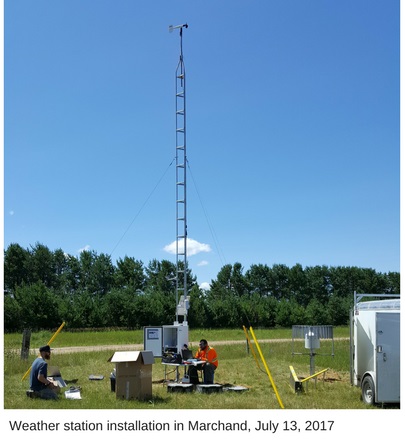To spray or not to spray? That is the question.
Ag weather network delivers a better way to watch the weather
 No one watches the weather more than a farmer and now Manitoba farmers have a better way to watch it.
No one watches the weather more than a farmer and now Manitoba farmers have a better way to watch it.Manitoba’s ag weather network has continued to expand over the past few years to give farmers important weather data so they can determine how best to take care of their crops.
“Farmers intuitively watch the weather. It’s in our DNA,” said Harry Sotas, who farms grains and oilseeds just east of Birtle. Wind speed and direction, humidity, rainfall, soil moisture and temperature - all are monitored and reflected in the everyday practice of taking care of one’s crops.
Timi Ojo, agriculture meteorology specialist for Manitoba Agriculture, works with farmers to strategize where weather stations are needed and should be placed as part of the province’s ag weather network to provide Manitoba growers with up-to-the-hour data.
“We collaborate with farmers on where to place weather stations on their property so that there is very minimal disruption to the farm, while still capturing the most ideal information on what is happening on the field to help with daily operations.”
In 2014, when the project was launched, Ojo said there were 46 weather stations placed on farmers’ properties; by the end of 2017, there will be 109.
With this amount of growth, thanks in large part to funding support from the Growing Forward 2 initiative, Manitoba is becoming a leader in the development of emerging weather partnerships with industry.
Philip Waldner is happy to have had a monitoring station placed on his land about a month ago. Waldner said he previously “used Starbuck or Portage to get information,” both towns being approximately 30 to 40 km away from his farm in Rosedale. Now, he gathers data from the local weather station on his property.
New weather stations benefit the community by providing precise local weather conditions and keeping a historical record for the area, allowing for year over year comparison.
Microclimate data in near real-time
Having access to data so close to the field, and in near real-time, gives growers an accurate look at what is taking place in the microclimate of their own farm.
“Knowing the hourly wind direction and velocity on your property is critical,” said Sotas.
“When spraying crops, it is important to have this information upfront to know if it is a good time to be spraying at all. You want to ensure that what you are spraying only goes where you intend it to go, and not potentially damage a neighbour’s crops or your own. Efficacy of the product is important. The weather station provides localized data to ensure conditions are right.”
Sotas says local information gives farmers confidence.
It’s important to know humidity levels to gauge if it is a good time to harvest, soil temperatures for seeding and rainfall levels to help determine crop yield. “Any information you have, helps,” said Sotas.
Aside from capturing statistics such as precipitation, wind velocity and humidity, as of late last year the new and updated weather stations around the province are testing soil moisture further down than what has been done in the past.
“Most weather monitoring stations do not have moisture probes and, if they do, they do not measure to the level of 50 and 100 cm down,” said Ojo. “This one element gives agriculturists a very good picture of the soil moisture status of the root system of their crops.”
Another significant benefit to Manitoba growers is that the weather data is available on the Manitoba Agriculture website for all to see. “In just one month this spring, the current weather conditions page had 7,300 visits, making it one of the most visited areas of the website,” Ojo said.
Network used by others
When gauging the success of the project, Ojo is seeing the user base of the ag weather project expanding beyond its primary agricultural audience.
“A federal agency that was looking into a crash contacted us because it occurred approximately two miles from the weather station. There was nothing else around that would give them any information regarding weather conditions at the time of the crash. They were able to use this data to investigate if weather was the cause. This station had only been installed about three months prior.”
Other users include the provincial flood forecasting group, fire prevention officials and the University of Manitoba.
Farmers, however, remain the chief benefactors of the program, giving them access to data that is central to providing a healthy harvest for Manitobans.

